Name Pyotr Velikiy Laid down 1986 Status in active service Construction started 1986 Beam 28 m | Namesake Peter the Great Commissioned 18 April 1998 Length 252 m Launched 1996 | |
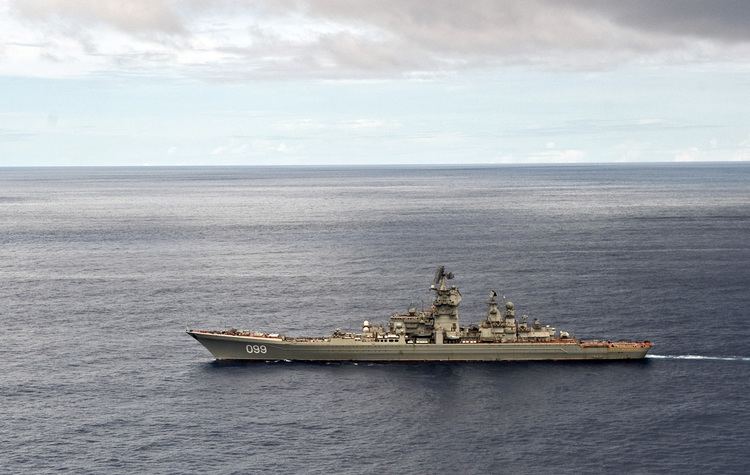 | ||
Class and type | ||
Pyotr Velikiy (Russian: Пётр Великий) is the fourth Kirov-class battlecruiser of the Russian Navy. Initially named Yuri Andropov (Russian: Юрий Андропов) for Yuri Andropov, the former General Secretary of the Communist Party, the ship's name was changed after the fall of the Soviet Union. The Russian designation for the type is "heavy missile cruiser", but Western defense commentators re-invented the term "battlecruiser" to describe these as they are the largest surface combatant warships in the world. Pyotr Velikiy is the flagship of the Northern Fleet.
Contents

Construction of the ship was heavily affected by the economic problems before and after the fall of the Soviet Union and it was not commissioned until 1998, twelve years after work had started. By then it had been renamed Pyotr Velikiy, Russian for Peter the Great. Pyotr Velikiy has been known to carry two pennant numbers during its service; "183" and currently "099".
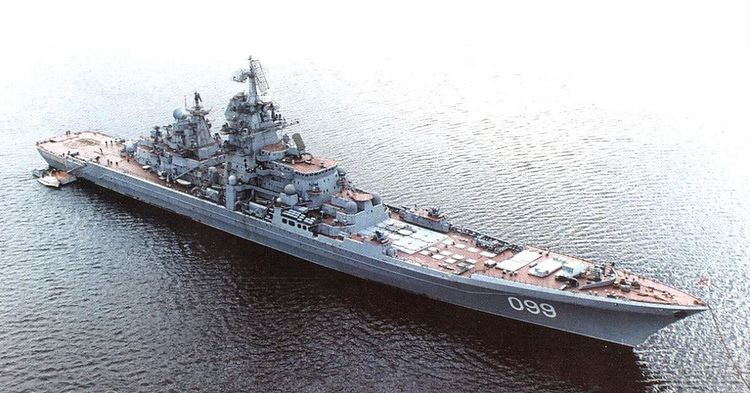
Service history
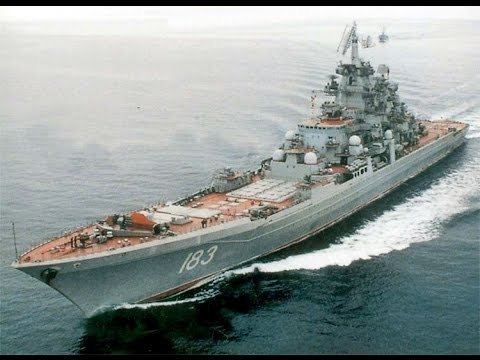
After completing its acceptance trials in November 1996, the vessel was transferred to the Northern Fleet at Severomorsk and became the flagship of the Northern Fleet.
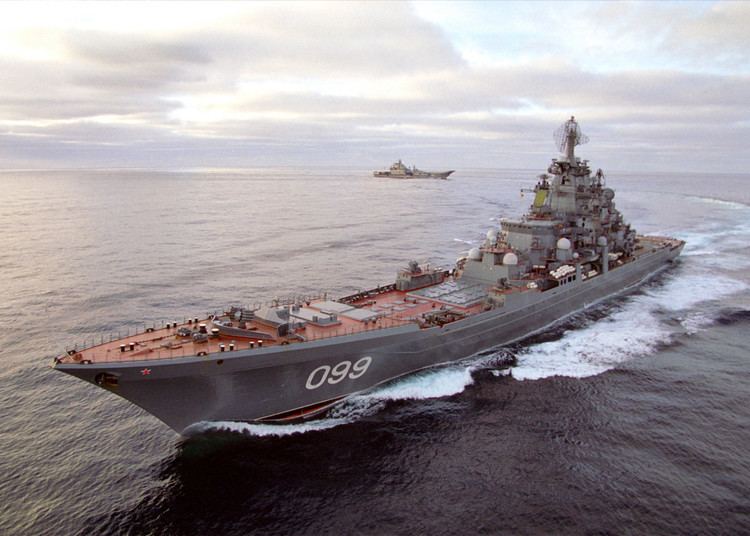
In August 2000 Pyotr Velikiy was in the Barents Sea involved in the largest naval training exercise since the fall of the Soviet Union. The ship was to be the designated target of the Oscar-II class submarine K-141 Kursk, and was conducting evasive maneuvers when communication with Kursk was lost, the submarine apparently having suffered a catastrophic torpedo detonation with all hands lost. Pyotr Velikiy guarded the area where the submarine sank during the subsequent salvage operation in 2001.
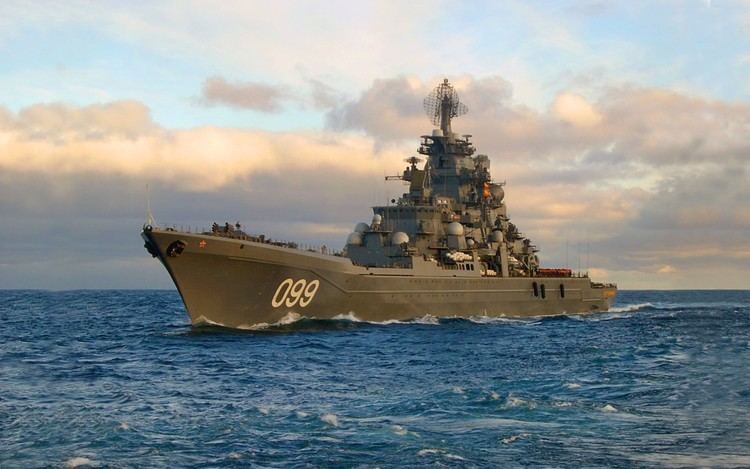
In March 2004, Russian Navy chief Admiral Vladimir Kuroyedov declared Pyotr Velikiy unfit for service due to problems with the ship's engineering maintenance. On 19 April 2004, the cruiser was docked in the floating drydock PD-50 for painting of the underside of the hull, repairs and examination of the steering system. The repairs were completed later that year, and it was carrying out missions again by August.
2008–09

On 8 September 2008, it was announced that Pyotr Velikiy would sail to the Caribbean Sea to participate in naval exercises with the Venezuelan Navy, along with the destroyer Admiral Chabanenko and other support ships. This action would represent the first major Russian show of force in that sea since the end of the Cold War. On 22 September Pyotr Velikiy and Admiral Chabanenko left their homeport of Severomorsk.
On 22 October 2008 Pyotr Velikiy made a port visit to Aksaz Karagac, Turkey and on 6–9 November the cruiser and Admiral Chabanenko made a port visit to Toulon, France, before departing the Mediterranean on 10 November, passing through the Strait of Gibraltar.
Pyotr Velikiy arrived in La Guaira, Venezuela on 25 November 2008 coinciding with a visit by Russian President Medvedev. A combined exercise, VENRUS-200, with the Venezuelan Navy took place on 1–2 December 2008. After finishing the exercises, Admiral Chabanenko made a short visit to Panama 5–10 December then to Bluefields, Nicaragua from 13 to 15 December and Havana, Cuba from 19–23 December.
Pyotr Velikiy continued alone to Cape Town, South Africa. On 11 January 2009, the chief of the Russian General Staff announced that Pyotr Velikiy and six other Russian warships would participate in a joint naval exercise with the Indian Navy later the same month. The Kirov-class cruiser paused for three days to visit Cape Town before continuing on to India.
On 31 January Pyotr Velikiy left the port of Mormugao in the Indian state of Goa. After a two-day visit that included a naval exercise with the Indian guided-missile destroyer INS Delhi the cruiser left for African waters where the vessel joined other warships from the Russian navy and conduct the INDRA-2009 exercise.
On 12 February, the ship captured 10 pirates in three boats off the coast of Somalia.
On 10 March Pyotr Velikiy returned to its homeport of Severomorsk, ending a six-month deployment.
2010
On 30 March 2010 Pyotr Velikiy left the Northern Fleet for a new six-month deployment. During its six-month tour of duty, the warship passed through the Atlantic Ocean and the Mediterranean Sea before entering the Indian Ocean via the Suez Canal. In the Indian Ocean the cruiser conducted maneuvers with other Russian warships from the Black Sea Fleet.
On 14 April the missile cruiser visited the Mediterranean port of Tartus in Syria. In September 2008, Russia was reported to be in talks with Syria about turning Tartus into a permanent base for Russian warships in the Middle East.
In early May 2010 Pyotr Velikiy met up with the cruiser Moskva in the South China Sea. There they conducted joint exercises and held a traditional farewell ceremony on 5 May. The two vessels were due to arrive in Russia's Far Eastern port of Vladivostok to take part in the Vostok-2010 large-scale strategic exercise.
On 29 September Pyotr Velikiy returned to its home base in the Northern Fleet after six months at sea. The flagship of the Northern Fleet had covered about 28,000 nautical miles (52,000 km; 32,000 mi) since the beginning of the mission on 30 March.
2013
During early September 2013 Pyotr Velikiy led a flotilla of Russian navy ships through the Russian portion of the Northern Sea Route in preparation for establishment of regular patrols.
2014
Pyotr Velikiy along with the aircraft carrier Admiral Kuznetsov and the tankers Segey Osipov, Kama and Dubna; the tugboat Altay, and the landing support ship Minsk entered the English Channel to sail north. The British destroyer HMS Dragon monitored the Russian task group as it neared the United Kingdom. Once the ships spotted each other they sailed briefly close by as a standard 'meet and greet'.
2016
In May 2016 the Pyotr Velikiy put to sea for the first time in two years for drills off the coast of Northern Russia. On October the 15th the Pyotr Velikiy left Severomorsk to escort the Heavy Aircraft Carrying Cruiser Admiral Kuznetsov to the Mediterranean along with supply ships and two Udaloy class destroyers, the Severomorsk and the Vice-Admiral Kulakov. Pyotr Velikiy passed through the English Channel, along with the rest of the Russian Northern Fleet on 21 October, shadowed by the British destroyer HMS Dragon.
